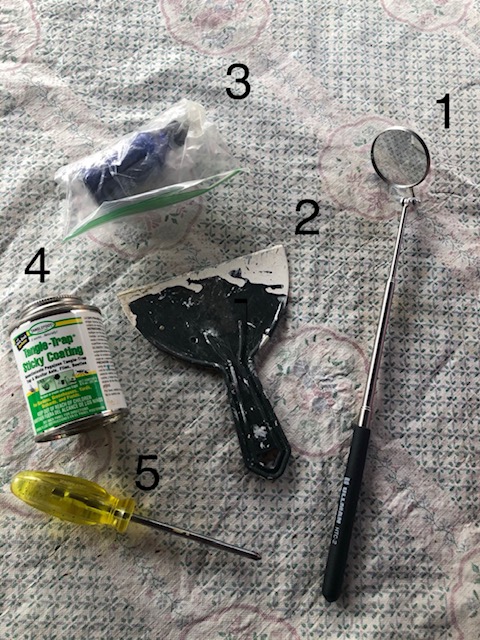Many of us include the Eastern Bluebird as a favorite, not just for its pleasing plumage and big black eyes but for its musical song and active insect hunting antics.
This season I started monitoring bluebird boxes at Seneca Lake State Park. It was a learning experience which started with my crash course in blue bird box monitoring with a local birder Dave Robertson who has been monitoring boxes at Montezuma for years. Training started with a fascinating show and tell of the items in his bag of bluebird monitoring tool kit. The following is a photo which displays some of the most important blue bird monitoring tools which I now have in my own
Bluebird tool kit.
1) mechanics mirror (my favorite) to view the nests safely without having to tilt the nest much
2) scraper for removing old nesting material from box in between nestings
3) oil for HOSP (house sparrows) eggs
4)Tangle Trap for kneeing ants out of nest box 5)screw driver for opening older boxes without easier access hardware
 |
| Add caption |
When monitoring a box with an active nest, I was surprised by the aggressiveness of the bluebird parents. Being dive bombed by blue birds, a fraction of my size was not something I bargained for, and even more surprising was the fact that a small song bird bird could make me anxious enough to abort a mission a time or two!
I was saddened by what could happen when nest boxes are not monitored regularly. For example, during our crash course training session in June we opened one of the boxes to find it full of old nest material with an active nest on top. The nestlings in the box would have had no “head room” because the nest was so close to the top of the box. The nest was also crawling with ants. Having ants in the box would have made the nestlings uncomfortable at the least at dangerous to their survival at the worst. To solve these problems we used the trusty old paint scraper to remove much of the old nest material from the middle of the nest to the bottom of the box. We then applied tangle trap on the nest box pole. The next time I monitored I was happy to see there were no ants at all and seemingly happy nestlings with room to grow!
Though I’m not sure what happened during the early spring season, from June on we fledged 10 EABL and 12 TRES from our lake side boxes. Dave Robertson’s numbers for 54 nest boxes at Montezuma was 65 EABL, and 177 TRES! He averages about 4.75-5.1 birds per box which is something to reach and hope for with our lake side monitoring next season.
If you’d like to help bluebirds in New York State consider joining our Bluebird Society which has seen a decrease in membership in recent years and is calling out for people to join. They maintain two different blue bird trails in NYS which promote the numbers of EABL and other cavity nesters. They also have a great website with brilliant member submitted photos of birds throughout the nation and a nice newsletter for members to enjoy. Membership is a mere $10/year. Join by logging onto NYSBS.org.












